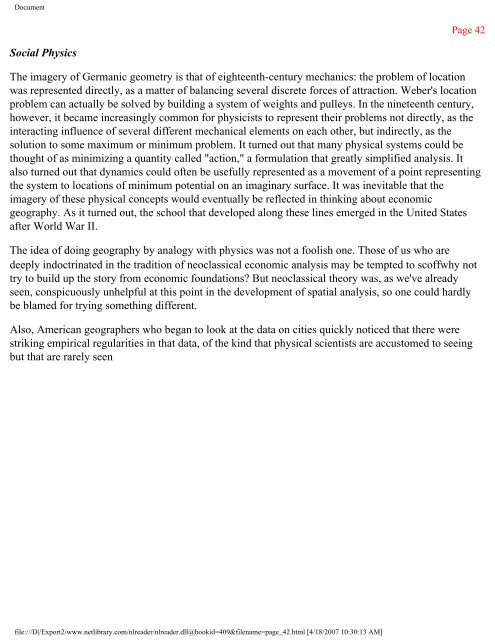Document file:///D|/Export1/www.netlibrary.com/nlreader/nlreader.dll ...
Document file:///D|/Export1/www.netlibrary.com/nlreader/nlreader.dll ...
Document file:///D|/Export1/www.netlibrary.com/nlreader/nlreader.dll ...
You also want an ePaper? Increase the reach of your titles
YUMPU automatically turns print PDFs into web optimized ePapers that Google loves.
<strong>Document</strong><br />
Social Physics<br />
Page 42<br />
The imagery of Germanic geometry is that of eighteenth-century mechanics: the problem of location<br />
was represented directly, as a matter of balancing several discrete forces of attraction. Weber's location<br />
problem can actually be solved by building a system of weights and pulleys. In the nineteenth century,<br />
however, it became increasingly <strong>com</strong>mon for physicists to represent their problems not directly, as the<br />
interacting influence of several different mechanical elements on each other, but indirectly, as the<br />
solution to some maximum or minimum problem. It turned out that many physical systems could be<br />
thought of as minimizing a quantity called "action," a formulation that greatly simplified analysis. It<br />
also turned out that dynamics could often be usefully represented as a movement of a point representing<br />
the system to locations of minimum potential on an imaginary surface. It was inevitable that the<br />
imagery of these physical concepts would eventually be reflected in thinking about economic<br />
geography. As it turned out, the school that developed along these lines emerged in the United States<br />
after World War II.<br />
The idea of doing geography by analogy with physics was not a foolish one. Those of us who are<br />
deeply indoctrinated in the tradition of neoclassical economic analysis may be tempted to scoff why not<br />
try to build up the story from economic foundations? But neoclassical theory was, as we've already<br />
seen, conspicuously unhelpful at this point in the development of spatial analysis, so one could hardly<br />
be blamed for trying something different.<br />
Also, American geographers who began to look at the data on cities quickly noticed that there were<br />
striking empirical regularities in that data, of the kind that physical scientists are accustomed to seeing<br />
but that are rarely seen<br />
<strong>file</strong>:///<strong>D|</strong>/Export2/<strong>www</strong>.<strong>netlibrary</strong>.<strong>com</strong>/<strong>nlreader</strong>/<strong>nlreader</strong>.<strong>dll</strong>@bookid=409&<strong>file</strong>name=page_42.html [4/18/2007 10:30:13 AM]
















